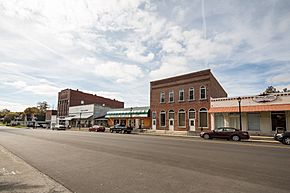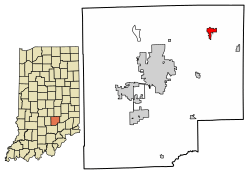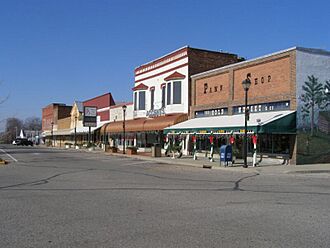Hope, Indiana facts for kids
Quick facts for kids
Hope, Indiana
|
|
|---|---|
 |
|

Location of Hope in Bartholomew County, Indiana.
|
|
| Country | United States |
| State | Indiana |
| County | Bartholomew |
| Township | Haw Creek |
| Area | |
| • Total | 0.95 sq mi (2.47 km2) |
| • Land | 0.95 sq mi (2.47 km2) |
| • Water | 0.00 sq mi (0.00 km2) |
| Elevation | 735 ft (224 m) |
| Population
(2020)
|
|
| • Total | 2,099 |
| • Density | 2,204.83/sq mi (851.00/km2) |
| Time zone | UTC-5 (EST) |
| • Summer (DST) | UTC-5 (EST) |
| ZIP code |
47246
|
| Area code(s) | 812 |
| FIPS code | 18-34744 |
| GNIS feature ID | 2397000 |
Hope is a town in Haw Creek Township, Bartholomew County, Indiana, United States. It is well-known for its historic buildings and charm. In 2010, the town had a population of 2,102 people. Hope is also part of the larger Columbus, Indiana, metropolitan area.
Contents
History of Hope
The area where Hope is now located was once home to the Delaware tribe. Later, the Miami tribe moved into the region. After some conflicts, the Miami tribe moved away. In 1816, Indiana became a state. In 1818, several Native American tribes signed treaties. These treaties opened up millions of acres of land in central Indiana for new settlers.
The first group of settlers arrived in Hope in 1830. They were Moravians, a type of Protestant Christian group. They came from Salem, North Carolina. Their leader was Rev. Martin Hauser, and the town's high school is named after him. The town was first called Goshen, like the place in the Bible. But in 1834, its name was changed to Hope. This was because another town in Indiana was already named Goshen. The name "Hope" shows the settlers' strong faith and optimism.
Hope was originally planned as a community where everyone shared property. However, this idea did not work well for a farming town. So, people were soon allowed to own their own land. The town also welcomed non-Moravian settlers.
Moravian Seminary for Young Ladies
In the mid-1800s, a Moravian day school opened in Hope. It later became a boarding school for young women. This school was called the Hope Moravian Seminary for Young Ladies. It opened in 1866. The school offered many subjects, including Latin, English, French, German, music, and math. Students came from many different states. The school closed in 1881. Today, you can still see the fancy iron gates on Main Street. These gates were given by former students. They mark the entrance to where the school once stood. The street is still called "Seminary Street."
Hope's Historic Downtown
Hope has kept many signs of its past. The entire downtown area is listed on the National Register of Historic Places. It is known as the Hope Historic District. You can learn about the town's history at the Yellow Trail Museum. This museum has two floors of old items donated by local people. Hope is also home to the Rural Letter Carriers' Museum. This museum celebrates the fact that Hope has the oldest continuous rural mail delivery in the United States, which started in 1896.
Hope celebrates its history each year with Hope Heritage Days. This event takes place on the last full weekend in September.
Newspaper and Architecture
Hope used to have its own newspaper, the Hope Star-Journal. It started in 1912 when two newspapers combined. After its editor passed away in 2014, the newspaper became an online publication. You can find it at Home - HSJ Online.
Hope is also special because it has three buildings designed by famous architects. These include Hope Elementary, the Hope Branch Library, and the Hope Star-Journal building. The Star-Journal building was originally a bank.
Geography
Hope covers a total area of about 0.95 square miles (2.47 square kilometers). All of this area is land.
Education and Athletics
Hope is home to Hauser Junior-Senior High School, which serves students in grades 7-12. It is part of the Flatrock-Hawcreek School Corporation. The school's mascot is the Jets, and their colors are black and white.
The school's sports teams have had great success. In 2006, the boys' basketball team won the Class A state championship. In 2015, the Lady Jets Softball team also won the Class A State Championship. This was the school's first state championship for a girls' team.
Hope also has a public library. It is a branch of the Bartholomew County Public Library.
Population Information
| Historical population | |||
|---|---|---|---|
| Census | Pop. | %± | |
| 1860 | 527 | — | |
| 1870 | 765 | 45.2% | |
| 1880 | 835 | 9.2% | |
| 1890 | 1,009 | 20.8% | |
| 1900 | 1,088 | 7.8% | |
| 1910 | 1,223 | 12.4% | |
| 1920 | 1,183 | −3.3% | |
| 1930 | 1,085 | −8.3% | |
| 1940 | 1,046 | −3.6% | |
| 1950 | 1,215 | 16.2% | |
| 1960 | 1,489 | 22.6% | |
| 1970 | 1,603 | 7.7% | |
| 1980 | 2,185 | 36.3% | |
| 1990 | 2,171 | −0.6% | |
| 2000 | 2,140 | −1.4% | |
| 2010 | 2,102 | −1.8% | |
| 2020 | 2,099 | −0.1% | |
| U.S. Decennial Census | |||
2010 Census Details
According to the 2010 census, there were 2,102 people living in Hope. There were 787 households and 561 families. The town had about 2,212 people per square mile.
Most of the people in Hope were White (97.1%). There were also small percentages of African American, Native American, and Asian residents. About 1.8% of the population was Hispanic or Latino.
The average age in Hope was 35.6 years old. About 25.7% of residents were under 18. About 11.2% were 65 years or older. The town had a nearly equal number of males (49.9%) and females (50.1%).
Culture
Hope has a strong connection to its history. This is shown through its Yellow Trail Museum and the local historical society. The town also holds annual events like Heritage Days and an Old-Fashioned Fourth of July. The downtown area has many old brick buildings and houses from the 1800s. You can also see one of Hope's original log cabins. Near the current school is the historic Simmons School. This was a one-room schoolhouse used from 1879 to 1907. Today, it hosts events and reenactments.
The town has an Art Guild, which supports local artists. Hope has also joined a movement to display "barn quilts." These are paintings of quilt squares on the sides of buildings. They are based on traditional folk art.
Hope is home to the only remaining Moravian church in Indiana. Many old Moravian traditions are still practiced here. For example, during Christmas, the church displays a "putz." This is an elaborate miniature Christmas scene. People also hang Moravian stars and make Moravian sugar cakes. These sweet cakes are often sold at local festivals.
More recently, a Mennonite community has brought traditional Mennonite foods to local stores. Hope is also trying to become a center for good food traditions. It has fresh local produce and the Simmons Winery. A farmer's market is held on the town square on Friday afternoons from June to September. You can also find fresh produce sold from local yards and farm stands.
Hope is also the starting point for the annual Hope Ride. This is a bicycling event that raises money for charity. Hundreds of cyclists come to Hope each September. They ride through the countryside, enjoying historic barns, churches, and monuments.
Hope also has a dinner theater called the Actors Studio of Hope. They put on several shows each year at the Willow Leaves venue on the town square.
On Groundhog Day (February 2), Hope celebrates on the town square. Local leaders dress in costumes. They watch a local groundhog, named Hope or her brother Frank, make a prediction about spring.
Hope's community groups work hard to bring businesses to the town. Despite its small size, Hope has many services. These include a Mexican restaurant, a cafe, an antique shop, a salon, a funeral home, and a dental office. There is also a chiropractor, a library, two parks, a bank, a pharmacy, a hardware store, and gas stations.
Author Philip Gulley wrote a novel called A Place Called Hope. This book is set in Hope, Indiana. However, the town in the book does not really look like the real Hope. Also, there is no Quaker church in the actual town of Hope.
Cemeteries
Moravian Cemetery
The Moravian Cemetery has a historic section with 1,070 graves. These graves are arranged in a special way, based on the "choir system." This system separates graves by gender and whether people were married. This tradition comes from Herrnhut, Germany, where Moravians found safety from religious persecution. The grave markers are often flat slabs. This shows the Moravian belief that everyone is equal after death. Some graves have a flat slab with a small area for flowers. This unique style is found only in this cemetery.
Notable Person
- Earl Hogan, a former member of the United States House of Representatives
See also
 In Spanish: Hope (Indiana) para niños
In Spanish: Hope (Indiana) para niños


